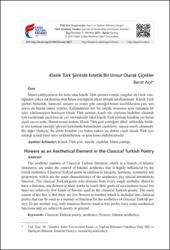| dc.contributor.author | Açıl, Berat | |
| dc.date.accessioned | 2015-07-02T13:08:21Z | |
| dc.date.available | 2015-07-02T13:08:21Z | |
| dc.date.issued | 2015-07 | |
| dc.identifier.citation | AÇIL, Berat. "Klasik Türk Şiirinde Estetik Bir Unsur Olarak Çiçekler." FSM İlmî Araştırmalar İnsan ve Toplum Bilimleri Dergisi, 5 (2015): 1-28. | en_US |
| dc.identifier.uri | http://dergi.fsm.edu.tr/index.php/ia/article/view/665/674 | |
| dc.identifier.uri | https://hdl.handle.net/11352/2188 | |
| dc.description.abstract | İslamî edebiyatların bir kolu olan klasik Türk şiirinin estetik yargıları da Grek estetiğinden
çokça etkilenmiş olan İslam estetiğinin etkisi altında şekillenmiştir. Klasik Türk
şairleri bütünlük, harmoni, simetri ve orantı gibi estetiğin temel özelliklerinin yanı sıra
işleve de büyük önem verirler. Kullandıkları her bir estetik nesnenin aynı zamanda bir
işlev yüklenmesini bekleyen klasik Türk şairleri, icazlı söz söyleme hedefine ulaşmak
için eserlerinde çiçeklere de yer vermişlerdir fakat klasik Türk şiirinde kendine yer bulan
çiçek sayısı azdır. Bunun temel nedeni, klasik Türk şiiri estetiğine dâhil edilmekle birlikte
söz konusu estetiğe işlevsel katkılarda bulunabilen çiçeklerin sayıca sınırlı olmasıdır.
Bir diğer ifadeyle, bu şiirde kendine yer bulan sadece on dokuz çiçek klasik Türk şiiri
estetiği içinde birer işlev yüklenebilmiş ve şiire konu olabilmişlerdir. | en_US |
| dc.description.abstract | The aesthetic statutes of Classical Turkish literature which is a branch of Islamic
literatures, are under the control of Islamic aesthetics that is highly influenced by the
Greek aesthetics. Classical Turkish poets in addition to integrity, harmony, symmetry and
proportion, which are the main characteristics of the aesthetics, pay special attention to
function. The classical Turkish poets who demand from every single aesthetic object to
have a function, use flowers in their works to reach their goals of succinctness (icaz) but
there are relatively few kinds of flowers used in the classical Turkish poetry. The main
reason of the fact is that there are few flowers in number which is included into classical
poetry that can be used as a manner of function for the aesthetics of classical Turkish poetry.
To put another way, only nineteen flowers used in this poetry have some aesthetical
functions and are subject to poetry in general. | en_US |
| dc.language.iso | tur | en_US |
| dc.publisher | FSM Vakıf Üniversitesi | en_US |
| dc.rights | info:eu-repo/semantics/openAccess | en_US |
| dc.subject | Klasik Türk şiiri | en_US |
| dc.subject | Estetik | en_US |
| dc.subject | Çiçekler | en_US |
| dc.subject | İslam estetiği | en_US |
| dc.subject | Classical Turkish poetry | en_US |
| dc.subject | Aesthetics | en_US |
| dc.subject | Flowers | en_US |
| dc.subject | Islamic aesthetics | en_US |
| dc.title | Klasik Türk Şiirinde Estetik Bir Unsur Olarak Çiçekler | en_US |
| dc.title.alternative | Flowers as an Aesthetical Element in the Classical Turkish Poetry | en_US |
| dc.type | article | en_US |
| dc.contributor.department | FSM Vakıf Üniversitesi, FSM İlmî Araştırmalar İnsan ve Toplum Bilimleri Dergisi | en_US |
| dc.relation.publicationcategory | Makale - Ulusal Hakemli Dergi - Kurum Öğretim Elemanı | en_US |



















